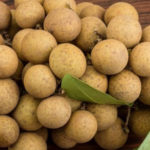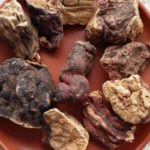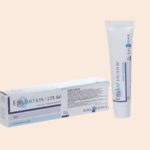Preserved wind-dried persimmons are not only an enticing snack but also an elegant gift. We share tips on how to keep them chewy and delicious, preventing spoilage.
1 How to Store Wind-Dried Persimmons
Typically, wind-dried persimmons are free from preservatives and manually sun-dried. Thus, proper storage is essential to maintain their chewy texture and freshness.
You can store wind-dried persimmons in the freezer compartment of your refrigerator to prolong their shelf life. When ready to eat, simply take them out and let them thaw for 5 to 10 minutes, or consume directly from the freezer. This method ensures the persimmons retain their quality and taste.
 Store wind-dried persimmons in the freezer compartment
Store wind-dried persimmons in the freezer compartment
However, it’s important to note that over-freezing can affect the quality of the persimmons.
Firstly, avoid buying wind-dried persimmons that are easily preserved outdoors or kept in the refrigerator’s cold compartment for more than two weeks without any sign of syrup formation. High-quality wind-dried persimmons, when stored in the refrigerator for 5 to 10 days, will start to form syrup or undergo fermentation, indicating they are free from chemical preservatives.
 Keep the stems intact and store in vacuum-sealed bags or airtight containers
Keep the stems intact and store in vacuum-sealed bags or airtight containers
Secondly, to extend the shelf life of wind-dried persimmons, it’s best to keep the stems intact and store the fruit in vacuum-sealed bags or airtight containers. Then, place them in the freezer compartment for long-term storage or in the cold compartment for immediate consumption, although they will only stay fresh for a few days.
Additionally, wind-dried persimmons from China may not be labeled as “made in China.” To verify their origin, simply peel off the sticker, as the product’s true origin will be revealed underneath.
For further reference:
2 Are Wind-Dried Persimmons with White Powder Safe to Eat?
It’s common to notice a white coating on wind-dried persimmons after purchasing them. You may worry that this indicates mold or spoilage, but rest assured, it’s merely a layer of sugar. During the sun-drying and wind-drying process, the persimmons are periodically massaged and kneaded (about once every five days) to enhance their softness and speed up the drying process.
 The white powder on wind-dried persimmons is a natural sugar coating
The white powder on wind-dried persimmons is a natural sugar coating
As the persimmons dry, they undergo a fermentation process, resulting in the formation of the white, sugary coating. This natural phenomenon not only enhances the sweetness but also adds a visually appealing touch.
3 Precautions When Consuming Wind-Dried Persimmons
Beware of Mistaking Sun-Dried Persimmons for Wind-Dried Ones
 Wind-dried persimmons have a deep brown color, while sun-dried ones are black
Wind-dried persimmons have a deep brown color, while sun-dried ones are black
Wind-dried persimmons have a deep brown color, whereas sun-dried persimmons are black. The faster drying process of sun-drying, compared to wind-drying, results in this color difference. When purchasing wind-dried persimmons, pay close attention to the color to ensure you’re getting the right product.
Opt for Deep Brown Wind-Dried Persimmons
The best wind-dried persimmons are those that have reached a certain level of ripeness and retained their firmness. After being hung to dry in the wind for three to four weeks, the persimmons develop a deep brown color, indicating optimal sweetness and flavor. At this stage, the persimmons will also start to ferment, resulting in a natural syrup formation.
 Choose wind-dried persimmons with a deep brown color for the best quality and taste
Choose wind-dried persimmons with a deep brown color for the best quality and taste
If the persimmons are not sufficiently ripe or are too soft when hung to dry, they may lack the necessary sugar content. As a result, the final product could be tough, bitter, and lacking in sweetness.
Select Persimmons with Stems Intact
When purchasing wind-dried persimmons, it’s advisable to choose those with their stems (or “tails”) still attached to ensure freshness and quality. During the production process, the stems are intentionally left on the fruit, and any persimmon without a stem is considered inferior and discarded.
 Choose wind-dried persimmons with intact stems to ensure freshness and quality
Choose wind-dried persimmons with intact stems to ensure freshness and quality
If you come across wind-dried persimmons without stems, it’s best to avoid them, as the absence of stems increases the risk of bacterial contamination and indicates a potential lack of hygiene during production.
Purchase Persimmons That Have Been Properly Dried
 Opt for wind-dried persimmons that have been hung to dry for the recommended duration
Opt for wind-dried persimmons that have been hung to dry for the recommended duration
The ideal drying time for wind-dried persimmons is three to four weeks. During this period, the persimmons not only retain their freshness but also develop their distinctive flavor. If the persimmons are hung for less than 12 days, they may become tough and less chewy due to inadequate kneading and massaging. Therefore, it’s best to purchase persimmons that have been properly dried to ensure optimal taste and texture.
Avoid Consuming Persimmons Past Their Expiration Date or With Strange Odors
 Discard wind-dried persimmons that have passed their expiration date or emit strange odors
Discard wind-dried persimmons that have passed their expiration date or emit strange odors
Most wind-dried persimmons have a shelf life of one year from the production date. It’s important not to consume persimmons that have exceeded this timeframe. Additionally, if you notice any strange, pungent, or foul odors during storage, discard the persimmons immediately, as they have likely spoiled.
The above guidelines provide insights into properly storing wind-dried persimmons to maintain their freshness and quality. We hope this information enhances your understanding of this delicacy and helps you make informed choices when purchasing and consuming wind-dried persimmons.






































